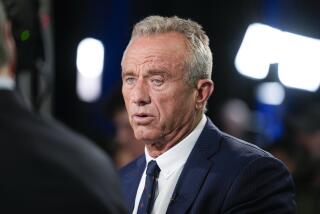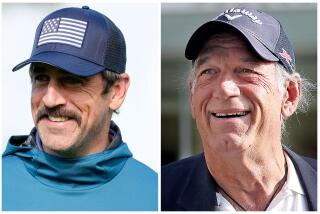Initial JFK Jr. Search Called Typical of Thousands
- Share via
WASHINGTON — The search for the remains of John F. Kennedy Jr. in the waters off Martha’s Vineyard, Mass., was more aggressive and sophisticated than efforts usually launched for average citizens.
But federal officials said that--at least in the early days when the focus was on finding survivors from Kennedy’s missing plane--the mission essentially was like thousands of others.
“Until just a couple of days ago . . . the rescue and recovery efforts that were undertaken were consistent with what would have been done in any other case,” President Clinton said at a news conference Wednesday. “Because the Coast Guard felt they had the capacity to succeed . . . and because of the role of the Kennedy family in our national lives . . . I thought it was appropriate to give them a few more days. And if anybody believes that was wrong, the Coast Guard is not at fault, I am.”
Once officials switched gears into a salvage effort to recover the bodies of Kennedy, his wife Carolyn Bessette Kennedy and her sister Lauren Bessette, unusual resources were added. For example, a Navy ship was used to recover the bodies and the wreckage. And science ships belonging to the National Oceanic and Atmospheric Administration were used to scan the sea bottom.
Few would quarrel with the special treatment accorded the only surviving son of an assassinated president.
“The initial response was heavy but reasonably normal,” said Drew Steketee, a vice president of the Aircraft Owners and Pilots Assn., which represents private pilots. “I think the public wanted to know what went wrong. It’s just the way Americans feel about their country.”
But many would be surprised to know the lengths to which federal and state agencies, as well as volunteers, go to rescue those who go down in small planes or who capsize in boats.
The federal government spends at least $370 million a year on search and rescue, most of it for Coast Guard operations. That organization alone handles more than 40,000 rescue cases annually, including between 400 and 500 plane crashes.
The other lead agency in the Kennedy case, the National Transportation Safety Board, investigated 1,907 accidents involving private planes last year, 361 of them fatal. The NTSB investigates all types of plane crashes, and it is not unusual to see the twisted crankshaft of a small propeller plane being analyzed at the board’s Washington metallurgy lab alongside the fan blades of an airliner’s jet engine.
Volunteers for the Civil Air Patrol, a federally funded Air Force auxiliary, fly more than 3,000 missions a year, most of them in search of downed pilots.
None of this includes the considerable expenses of state and local governments and volunteer groups.
The Federal Aviation Administration radar tapes used to determine where the Kennedy plane went down are part of an extensive system for tracking small planes that fail to show up at their destinations.
Lives of searchers were not at stake in the Kennedy case, but rescuers often put themselves in jeopardy without knowing the identities of the people they are trying to rescue.
In 1997, seven Coast Guard service members were killed in two separate rescue missions, each involving sailboats that foundered in heavy weather. Four helicopter crew members perished off Cape Mendocino in Nothern California on a stormy June night as they prepared to lower a rescue basket to five Canadian sailors in a life raft. The low-flying helicopter may have been caught by a wave, experts believe. The Canadians were rescued by a Coast Guard cutter, which then began searching for the lost helicopter.
“There is a tremendous amount of energy for search and rescue because it is a human response,” said Chuck Mills, a program officer of the National Assn. for Search and Rescue, an educational nonprofit organization in Chantilly, Va. “It’s not based on who you are.”
A recent crash at a Massachusetts seaside community provides some perspective for the Kennedy operation.
In October, a lawyer from Albany, N.Y., ditched his private plane in the sea while approaching the Provincetown airport during a fierce storm. Ron Sinzheimer and his dog apparently tried to swim for shore.
Literary agent Michael Snell, a friend of the Sinzheimer family, said that the Coast Guard and local police searched four or five days until the bodies of Sinzheimer and his pet chow washed up on different sides of Cape Cod. The search involved a helicopter, a jet, two Coast Guard boats and people on the ground who scoured the dunes of the Cape Cod National Seashore on the chance that the plane might have crashed there. For the Kennedy search, the Coast Guard alone deployed at least 10 boats.
Sinzheimer’s family is comfortable with what was done in the Kennedy crash. “I asked Ron’s widow,” Snell said, “and she said, ‘I love the Kennedys, and I’m glad they’re doing everything they’re doing. Sure it’s not the same thing they did for Ron, but I’m not angry.’ ”
Snell said that he does not think the Coast Guard did too little for his friend, nor does he think it did too much for Kennedy. “Both are right for different reasons.”
The technology used in the attempt to locate Kennedy’s plane was no different from that used in other missions. A radar taping system allows rescuers to find small planes whose pilots, like Kennedy, fly without filing flight plans.
“You use radar, weather information and intelligence about the people involved and that gets you to the needle in the haystack most of the time,” said Jim Bigelow, a retired Civil Aviation Patrol official from Belmont, Calif., who helped design the system in the 1970s.
But other things set the Kennedy search apart.
The Grasp, the salvage ship carrying deep sea divers, never before had assisted in the recovery of a general aviation aircraft, for example. “This is the first time I know of,” said Navy spokeswoman Lt. Meghan Mariman. “It is very rare that we would search for a small civilian plane.”
The Coast Guard and the Navy said that they have no estimate of the cost of the search. Much of that cost would be the fixed expense of maintaining ships and aircraft and paying their crews. Coast Guard officials said that they did not divert rescuers from other missions to assist in the Kennedy search.
The high level of public interest and the ceaseless media coverage contributed to the decision to add resources, federal officials said. With the Kennedy story on television around the clock, no agency involved in the search or investigation wanted to appear lackadaisical.
“If there was no media interest, we wouldn’t need to have as many people here,” said Phil Frame, a spokesman for the National Transportation Safety Board. Three public relations officials, to say nothing of the board chairman, joined the contingent.
Cmdr. Pat Philbin, a spokesman for Adm. James Loy, the Coast Guard commandant, said that response from the public has been positive.
Among Coast Guard, Navy and Massachusetts rescuers, there is what some are calling a “Saving Private Ryan” attitude--a sense that helping bring closure to the Kennedy family and the nation is valuable in its own right.
“I think that there is a perspective that it’s the right thing to do,” Philbin said. “If we had an unending ability, we would do it in every case. In this instance, because of the contribution the Kennedy family has made, I think it’s important for many Americans.”
More to Read
Sign up for Essential California
The most important California stories and recommendations in your inbox every morning.
You may occasionally receive promotional content from the Los Angeles Times.










